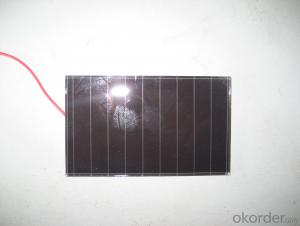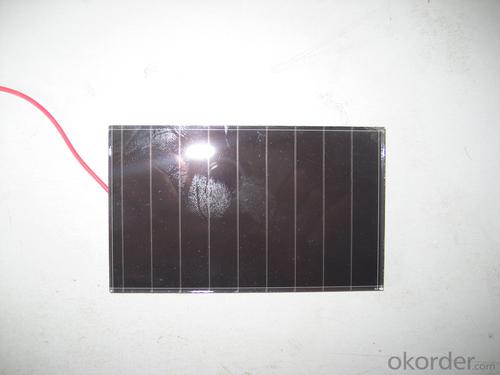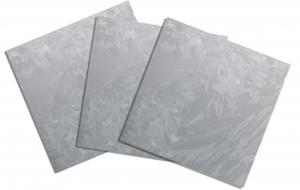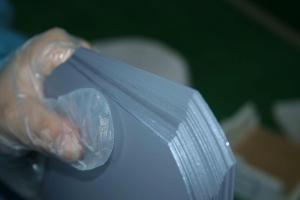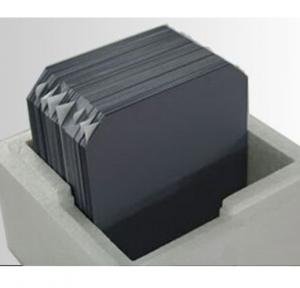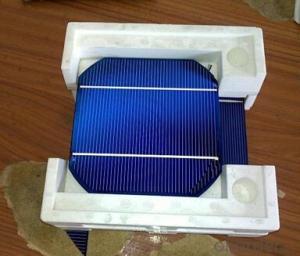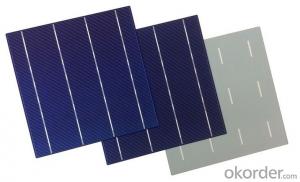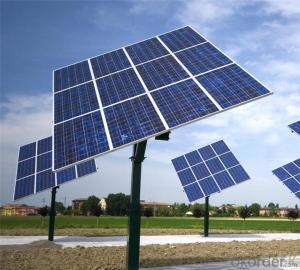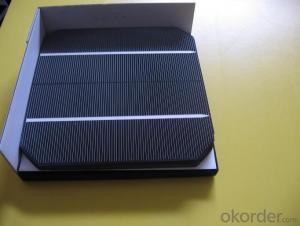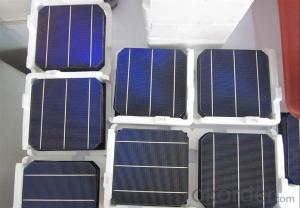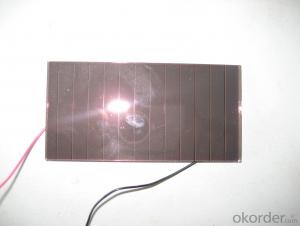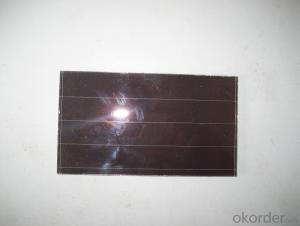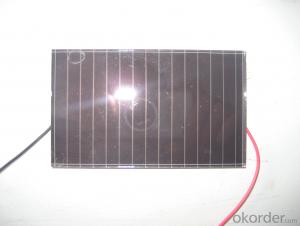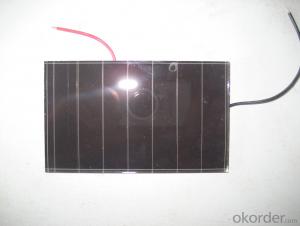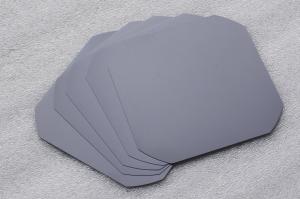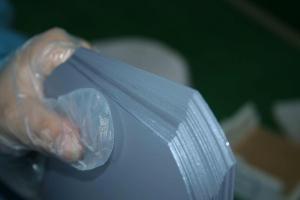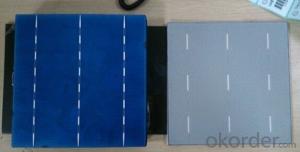Solar Mono Silicon Wafer Amorphous Silicon Dice Specification 2
- Loading Port:
- China Main Port
- Payment Terms:
- TT OR LC
- Min Order Qty:
- -
- Supply Capability:
- -
OKorder Service Pledge
OKorder Financial Service
You Might Also Like
Pv modules at present, the mainstream products are still in silicon as the main raw materials, only in terms of silicon raw material consumption, production 1 mw of crystalline silicon solar cell, need 10 to 12 tons of high purity silicon, but if use the same silicon materials used to produce thin film amorphous silicon solar cell can produce more than 200 mw.
From the perspective of energy consumption, amorphous silicon solar battery only 1-1.5 years of energy recovery period, more embodies its contribution to energy saving in the manufacturing process.
Component occupies a high proportion of costs in a photovoltaic system, the component prices directly affect the system cost, and thus affect the cost of photovoltaic power generation. Calculated at the current price of components, the same money, buy amorphous silicon products, you can get more close to 30% of the power components.
2, more power
For the same power of solar cell array, amorphous silicon solar cell is about 10% more than monocrystalline silicon, polycrystalline silicon battery power. This has been the Uni - Solar System LLC, Energy Photovoltaic Corp., Japan's Kaneka Corp., the Netherlands Energy research institute, and other organizations and experts confirmed that the Photovoltaic industry.
In sunny, that is to say, under the high temperature, amorphous silicon solar cell components can show more excellent power performance.
3, better low light response
Due to the characteristics of amorphous silicon atoms are arranged disorderly, the electron transition no longer comply with the restriction of traditional \"selection rule\", as a result, its light absorption characteristics and there are big differences monocrystalline silicon material. Amorphous silicon and monocrystalline silicon material absorption curve as shown
, amorphous silicon absorption curve has obvious three sections (A, B, C). Area A corresponding electronic transition between localized states, such as the gap state near Fermi level and to the tail state transition, the absorption coefficient is small, about 1-10 cm - 1, for this is absorbing; B area absorption coefficient with the increase of the photon energy index rose, it corresponds to the electrons from the valence band edge extension state to the conduction band localized state transition, as well as the localized electrons from the valence band tail states guide for edge extension state transition, the region's energy range is usually only about half of the electron volts, but absorption coefficient across two or three orders of magnitude, usually up to 104 cm - 1; Area C corresponds to the electrons from the valence band to the conduction band internal internal transition, the absorption coefficient is bigger, often in more than 104 cm - 1. After two absorption area is crystalline silicon eigen absorption area.
Can be seen in the figure, the intersection of two curves about 1.8 ev. It is important to note that in the visible light range (1.7 to 3.0 ev), the absorption coefficient of amorphous silicon material is almost an order of magnitude larger than the single crystal silicon. That is to say, in the morning the first part of the sun is not too strong, the second half, and it's cloudy in the afternoon under the condition of low light intensity, long wave is greater, the amorphous silicon material still has a large absorption coefficient. Again considering the amorphous silicon band gap is larger, the reverse saturation current I0 is smaller. And as mentioned the amorphous silicon battery the characteristics I - V characteristic curve of the amorphous silicon solar cell both in theory and in practical use in low light intensity has good adaptation.
• I - V characteristics of amorphous silicon cells after more than a Vm with the voltage drop slowly
In order to be convenient, we draw the I - V characteristics of two kinds of batteries on the same picture. Crystalline silicon and amorphous silicon battery I - V characteristics of general shape as shown
we see from the picture, two kinds of cells in the curve changes after exceed the maximum output power point gap is bigger. Output current of crystalline silicon cells after exceed the maximum output power point will soon fall to zero, curve steep; Rather than crystalline silicon cells output current after a long distance to fall to zero, the curve is relatively flat. Two kinds of battery Vm equivalent to about 83% of its open circuit voltage and 83% respectively.
when light intensity gradually become hour, short circuit current and open circuit voltage of solar battery will be stronger. Short circuit current decreases faster, of course, open circuit voltage decrease more slowly.
do in battery solar cell array under the condition of load, when the sun battery array of effective output voltage less than the terminal voltage of battery, battery cannot be recharged. When the light intensity gradually become hour, crystal silicon battery charging does not meet the conditions, and amorphous silicon due to the larger voltage difference, do not charge until the light is very dark, effectively increase the use of sunlight time. So, amorphous silicon cells to produce more electricity than the crystalline silicon.
4, more excellent high temperature performance
High in the outdoor environment temperature, amorphous silicon solar cell performance change, depends on the temperature, spectrum, as well as other related factors. But what is certain is: amorphous silicon than monocrystalline silicon or polycrystalline silicon are less likely to be affected by temperature.
Amorphous silicon solar cells than monocrystalline silicon, polycrystalline silicon cells have relatively small temperature coefficient of amorphous silicon solar cell output power best Pm temperature coefficient is about 0.19%, and monocrystalline silicon, polycrystalline silicon cells best output power Pm temperature coefficient is about 0.5%, when the battery work at higher temperatures, the two batteries will be a drop in the Pm, but the decline is different. They can be calculated using the following formula.
- Q: How are solar silicon wafers protected from electromagnetic interference?
- Solar silicon wafers are typically protected from electromagnetic interference through the use of shielding materials and techniques. These measures include enclosing the solar panels within a grounded metal frame or casing, which acts as a Faraday cage to block external electromagnetic waves. Additionally, specialized coatings or films may be applied to the surface of the wafers to further enhance their resistance to electromagnetic interference.
- Q: How are solar silicon wafers affected by temperature coefficient?
- The temperature coefficient refers to how the performance of solar silicon wafers is affected by changes in temperature. When the temperature increases, the efficiency of the solar cell decreases due to an increase in electron-hole recombination and a decrease in the open-circuit voltage. Conversely, when the temperature decreases, the efficiency of the solar cell increases. Therefore, the temperature coefficient is an important factor to consider for optimizing the performance and output of solar silicon wafers in different temperature conditions.
- Q: The higher the resistivity of silicon wafers, the better?!!! 1 experts please answer me!
- Weak questions: why single crystal resistivity in about 1 would be better?
- Q: What is the size of a typical solar silicon wafer?
- A typical solar silicon wafer is typically 156 mm (6.14 inches) in size.
- Q: Can solar silicon wafers be used in solar-powered air conditioners?
- Yes, solar silicon wafers can be used in solar-powered air conditioners. These wafers are commonly used in solar panels to convert sunlight into electricity. In solar-powered air conditioners, the electricity generated by the silicon wafers can be used to power the cooling mechanism, providing an energy-efficient and sustainable alternative to traditional air conditioners.
- Q: Can solar silicon wafers be used in marine applications?
- Yes, solar silicon wafers can be used in marine applications. However, additional precautions and protective measures need to be taken to ensure their durability and longevity in the harsh marine environment, such as sealing them against moisture and corrosion.
- Q: How do solar silicon wafers perform in urban environments?
- Solar silicon wafers perform well in urban environments due to their ability to efficiently convert sunlight into electricity. However, certain factors such as shading from tall buildings and pollution can impact their performance. Overall, with proper installation and maintenance, solar silicon wafers can effectively generate renewable energy even in urban settings.
- Q: Are solar silicon wafers affected by electromagnetic fields?
- Yes, solar silicon wafers can be affected by electromagnetic fields. Electromagnetic fields can induce eddy currents in the wafers, leading to resistive losses and reduced efficiency in solar cell performance. However, the impact of electromagnetic fields on solar silicon wafers is generally minimal as solar cells are designed to minimize such effects and maintain their functionality.
- Q: Can solar silicon wafers be used in tandem solar cell configurations?
- Yes, solar silicon wafers can be used in tandem solar cell configurations. Tandem solar cells involve stacking multiple solar cells with different bandgaps to increase the overall efficiency of the solar module. Silicon wafers are commonly used as one of the materials in tandem solar cells due to their abundance and cost-effectiveness.
- Q: How does the size of a solar silicon wafer affect its performance?
- The size of a solar silicon wafer directly affects its performance. Larger wafers have a higher surface area, allowing for more solar cells to be fabricated, resulting in increased power output. Additionally, larger wafers can capture more sunlight, maximizing energy conversion efficiency. However, larger wafers also require more material and may face challenges during the manufacturing process. Overall, the size of a solar silicon wafer impacts its performance by determining the amount of energy it can generate and the cost-effectiveness of the manufacturing process.
Send your message to us
Solar Mono Silicon Wafer Amorphous Silicon Dice Specification 2
- Loading Port:
- China Main Port
- Payment Terms:
- TT OR LC
- Min Order Qty:
- -
- Supply Capability:
- -
OKorder Service Pledge
OKorder Financial Service
Similar products
Hot products
Hot Searches
Related keywords
